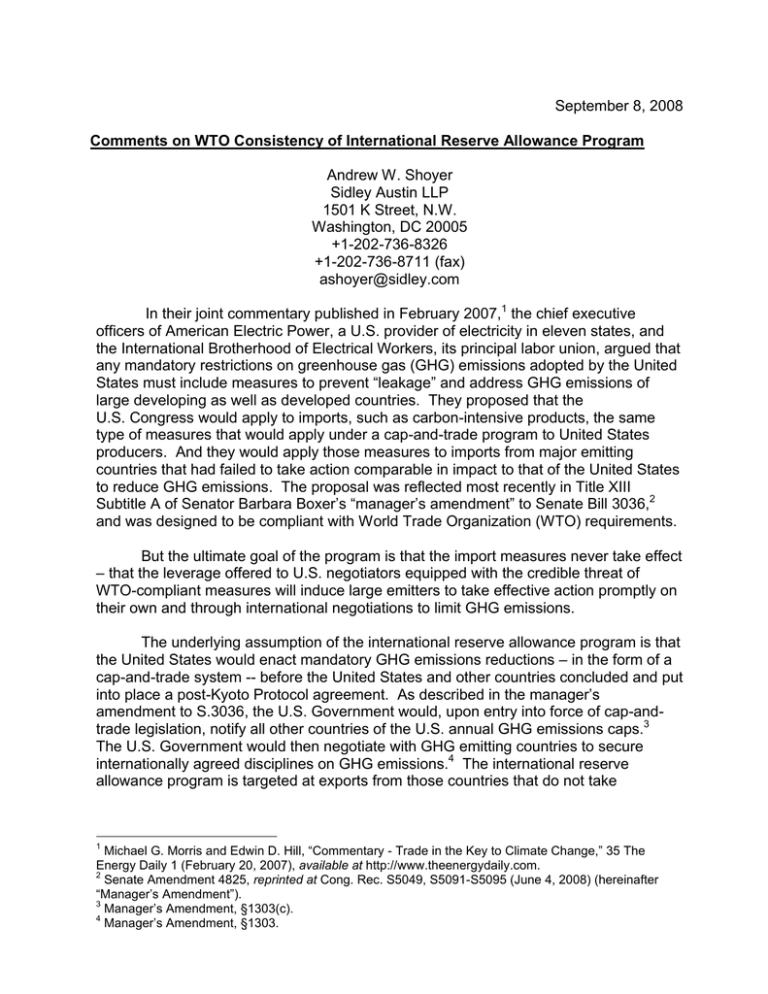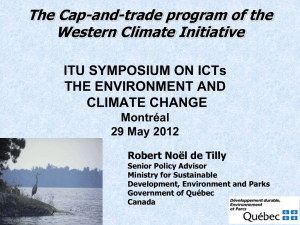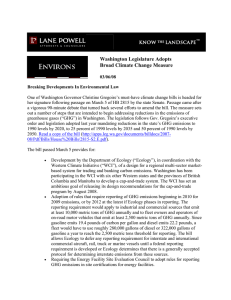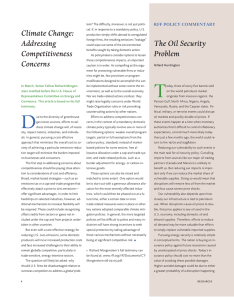September 8, 2008 Andrew W. Shoyer Sidley Austin LLP 1501 K Street, N.W.
advertisement

September 8, 2008 Comments on WTO Consistency of International Reserve Allowance Program Andrew W. Shoyer Sidley Austin LLP 1501 K Street, N.W. Washington, DC 20005 +1-202-736-8326 +1-202-736-8711 (fax) ashoyer@sidley.com In their joint commentary published in February 2007,1 the chief executive officers of American Electric Power, a U.S. provider of electricity in eleven states, and the International Brotherhood of Electrical Workers, its principal labor union, argued that any mandatory restrictions on greenhouse gas (GHG) emissions adopted by the United States must include measures to prevent “leakage” and address GHG emissions of large developing as well as developed countries. They proposed that the U.S. Congress would apply to imports, such as carbon-intensive products, the same type of measures that would apply under a cap-and-trade program to United States producers. And they would apply those measures to imports from major emitting countries that had failed to take action comparable in impact to that of the United States to reduce GHG emissions. The proposal was reflected most recently in Title XIII Subtitle A of Senator Barbara Boxer’s “manager’s amendment” to Senate Bill 3036,2 and was designed to be compliant with World Trade Organization (WTO) requirements. But the ultimate goal of the program is that the import measures never take effect – that the leverage offered to U.S. negotiators equipped with the credible threat of WTO-compliant measures will induce large emitters to take effective action promptly on their own and through international negotiations to limit GHG emissions. The underlying assumption of the international reserve allowance program is that the United States would enact mandatory GHG emissions reductions – in the form of a cap-and-trade system -- before the United States and other countries concluded and put into place a post-Kyoto Protocol agreement. As described in the manager’s amendment to S.3036, the U.S. Government would, upon entry into force of cap-andtrade legislation, notify all other countries of the U.S. annual GHG emissions caps.3 The U.S. Government would then negotiate with GHG emitting countries to secure internationally agreed disciplines on GHG emissions.4 The international reserve allowance program is targeted at exports from those countries that do not take 1 Michael G. Morris and Edwin D. Hill, “Commentary - Trade in the Key to Climate Change,” 35 The Energy Daily 1 (February 20, 2007), available at http://www.theenergydaily.com. 2 Senate Amendment 4825, reprinted at Cong. Rec. S5049, S5091-S5095 (June 4, 2008) (hereinafter “Manager’s Amendment”). 3 Manager’s Amendment, §1303(c). 4 Manager’s Amendment, §1303. “comparable action” to that taken by the United States.5 The U.S. Government would begin to measure on an annual basis the reduction of GHG emissions under the U.S. cap and use those data to determine whether and to what extent other countries had taken “comparable action.” The determination of whether a country had taken “comparable action” would be based, therefore, on the impact of a country’s regulation on GHG emissions rather than the precise form of the regulatory program used to achieve those effects.6 The U.S. Government would focus its determination on those countries that contribute most to global GHG emissions – least developed countries and countries with less than a de minimis volume of GHG emissions would be excluded from the international reserve allowance requirements.7 If the U.S. Government determined that a country did not take comparable action, then an importer of certain goods (e.g., carbon-intensive goods such as steel and aluminum) from that country would be required to provide allowances to the U.S. Government corresponding to the GHGs emitted when the imported goods were produced in the country of origin.8 The U.S. Government would use an adjustment factor in setting the number of allowances required for imported goods.9 This adjustment factor would reflect the portion of allowances that domestic producers receive at no cost in relation to the allowances that domestic producers procure by auction.10 The adjustment factor would also reflect the conditions prevailing in different countries. The U.S. Government would permit importers to satisfy their obligations using allowances (and credits) generated under the cap-and-trade systems of other countries, or using “international reserve” allowances sold by the U.S. Government at the prevailing price of U.S. cap-and-trade allowances.11 There would be no limit to the number of international reserve allowances made available for purchase by importers, and these international reserve allowances could not be used by U.S. regulated entities to satisfy their obligations under the U.S. cap-and-trade system.12 It is noteworthy, as described below, that the international reserve allowance program is designed to fall within the exception of the WTO General Agreement on Tariffs and Trade (GATT) for measures relating to the conservation of exhaustible natural resources, by: (1) securing a close "ends-means" relationship with the overall environmental objectives of the cap-and-trade program; (2) implementing measures in conjunction with limitations on US production, in an "even-handed" fashion so that foreign goods are not treated worse than domestic goods; (3) adjusting import requirements to take into account different conditions among countries; (4) allowing time for good faith negotiating efforts with all affected countries; and 5 Senate Amendment 4825, Sections 1301(4),1305 reprinted at Cong. Rec. S5049, S5091-S5092 (June 4, 2008). 6 Id. 7 Manager’s Amendment, §1306(b)(2). 8 Manager’s Amendment, §1306(c). 9 Manager’s Amendment, §1306(d). 10 Manager’s Amendment, §1306(d)(4). 11 Manager’s Amendment, §1306(e). 12 Manager’s Amendment, §1306(a)(7). 2 (5) allowing time to measure U.S. emissions reductions before imposing trade measures. Each of these elements is discussed in turn: (1) The program provides a real solution to the conservation objective of reducing GHG emissions. GATT Article XX(g) provides a general exception to the GATT’s substantive obligations only for those government measures that are “primarily aimed at” the conservation of exhaustible natural resources. In its US – Shrimp decision,13 the WTO Appellate Body recognized that a government measure was primarily aimed at the conservation of an exhaustible natural resource if “a close and genuine relationship of ends and means” exists between the measure and the conservation objective.14 Under the international reserve allowance program, importers could meet the requirements by providing allowances from recognized cap-and-trade programs outside the United States, or by securing international reserve allowances from the U.S. Government, both of which are designed to reflect actual GHG emissions abroad. In contrast, a carbon tax on imports would have no direct relationship to the reduction of emissions abroad. (2) The program, which would place restrictions on the importation of certain foreign products, is implemented in parallel with restrictions on domestic production. GATT Article XX(g) applies “if such measures are made effective in conjunction with restrictions on domestic production or consumption” -- language that the WTO Appellate Body has interpreted as requiring “even-handedness.”15 In other words, as explained by the Appellate Body in US – Gasoline,16 restrictions on imported products must be “promulgated or brought into effect together with restrictions on domestic production or consumption of natural resources.”17 However, the Appellate Body also made clear in its US – Gasoline decision that GATT Article XX(g) does not require “identical treatment of domestic and imported products.”18 (3) The program is structured so as to take into consideration the different conditions that may exist in affected exporting countries. According to the Appellate Body in US – Shrimp, the chapeau of GATT Article XX requires that a government measure “be designed in such a manner that there is sufficient flexibility to take into account the specific conditions prevailing in any 13 See Appellate Body Report, United States – Import Prohibition of Certain Shrimp and Shrimp Products, WT/DS58/AB/R, adopted 6 November 1998, DSR 1998:VII, 2755 (“US – Shrimp (AB)”); Appellate Body Report, United States – Import Prohibition of Certain Shrimp and Shrimp Products – Recourse to Article 21.5 of the DSU by Malaysia, WT/DS58/AB/RW, adopted 21 November 2001, DSR 2001:XIII, 6481 (“US – Shrimp: 21.5 Proceedings (AB)”). 14 US – Shrimp (AB), at para.136. 15 US. – Gasoline (AB), p. 20-21; US-Shrimp (AB), at paras. 144-45. 16 Appellate Body Report, United States – Standards for Reformulated and Conventional Gasoline, WT/DS2/AB/R, adopted 20 May 1996, DSR 1996:I,3 (“”US -- Gasoline (AB)”); Panel Report, United States – Standards for Reformulated and Conventional Gasoline, WT/DS2/R, adopted 20 May 1996, as modified by Appellate Body Report, WT/DS2/AB/R, DSR 1996:I, 29 (“US -- Gasoline (Panel)”). 17 US -- Gasoline (AB), p. 18. 18 US -- Gasoline (AB), p. 21. 3 exporting Member.”19 In contrast, a single carbon-intensity standard for all products in a particular sector could not meet this requirement. In its US – Shrimp decision, the Appellate Body found unacceptable government measures that “require other [WTO] Members to adopt essentially the same comprehensive regulatory program, to achieve a certain policy goal, as that in force within that Member’s territory, without taking into consideration different conditions which may occur in the territories of those other Members.”20 Moreover, the Appellate Body has found a government measure that “condition[s] market access on the adoption of a programme comparable in effectiveness” (versus the same program) satisfies the chapeau’s requirements because the measure permits sufficient flexibility in its application.21 (4) The program provides sufficient time for the U.S. Government to engage in serious negotiations with all affected countries to curb GHG emissions before the international allowance requirement would enter into effect. The Appellate Body rejected the government measure at issue in US – Shrimp in part because of “[t]he failure of the United States to engage the appellees, as well as other Members exporting shrimp to the United States, in serious, across-the-board negotiations with the objective of concluding bilateral or multilateral agreements for the protection and conservation of sea turtles, before enforcing the import prohibition against the shrimp exports of those other Members.”22 Moreover, in US – Shrimp, the Appellate Body found a violation of the anti-abuse provisions in the chapeau because “the United States negotiated seriously with some, but not with other Members” that were similarly situated.23 To be clear, the Appellate Body has not interpreted GATT Article XX to require that WTO Member government negotiate with other governments before it imposes an environmental measure is imposed. Rather, the chapeau of GATT Article XX requires non-discrimination, so that if a WTO Member government chooses to negotiate with some countries, it must negotiate with all countries that would be affected by a measure. The United States is already negotiating climate issues with other nations, and the United States will discuss the application of the international allowance provision with some of the nations that are affected by it. To meet the GATT Article XX criteria, therefore, the United States will be obligated to negotiate with all of the countries to which the provision will be applied (but not those exempted from the measure), because the United States will be negotiating with some of them. The United States is not required to conclude negotiations – only to make serious, good-faith efforts with all (approximately thirty) affected countries. The negotiations could commence immediately upon passage of the legislation and enactment into law. Thus, the requirement to negotiate does not affect the date on which the allowance requirement would be imposed on imports from affected countries. 19 US – Shrimp: 21.5 Proceedings (AB), at para. 149. US – Shrimp (AB), at para. 164. 21 US – Shrimp: 21.5 Proceedings (AB), at para. 144. 22 US – Shrimp (AB), at para. 166. 23 US – Shrimp (AB), at para. 172. 20 4 (5) The program imposes the international allowance requirement on imports after the cap-and-trade requirements would apply to domestic production, so that importers are provided in advance the standard of comparability of action. In US – Tuna I,24 the GATT 1947 Panel noted (in an unadopted report) that because the United States had “linked the maximum incidental dolphin-taking rate which Mexico had to meet during a particular period in order to be able to export tuna to the United States to the taking rate actually recorded for United States fisherman during the same period,” the “Mexican authorities could not know whether, at a given point of time, their conservation policies conformed to the United States conservation standards.”25 The Panel concluded that “a limitation on trade based on such unpredictable conditions could not be regarded as being primarily aimed at the conservation of dolphins.”26 Under the international reserve allowance program, the President would be required immediately upon enactment to notify other countries of annual U.S. emission caps provided in the legislation, providing a predictable standard several years in advance in respect of which foreign countries would adjust their GHG emissions regulations. But the allowance requirement would be applied on imports only after the U.S. Government measured emissions reduction in the United States and provided that standard of “comparability” to producers in and importers from affected countries. Under WTO jurisprudence, the United States must apply the measure to affected countries in an “even-handed” manner as compared to the manner in which it is applied to U.S. production or consumption.27 If the United States requires concrete verification and measurable results in exporting countries, it will be difficult for the United States to justify not doing so with respect to the results achieved domestically under the cap. On the other hand, if the United States were to apply the allowance requirement on imports immediately upon the application of the cap inside the United States, without any measurement or verified results of GHG emissions reductions, then “evenhandedness” would appear to require the United States to treat affected foreign countries in a similar fashion – without any measurement or verification of GHG emissions abroad. 24 Panel Report, United States – Restrictions on Imports of Tuna (Tuna I), DS21/R, GATT BISD 39S/155 (circulated 3 September 1991; not adopted). 25 Tuna I, at para. 5.28. 26 Id. 27 US – Gasoline (AB), p. 20-21; US -- Shrimp (AB), at paras. 144-45. 5 DC1 1254760v.1






